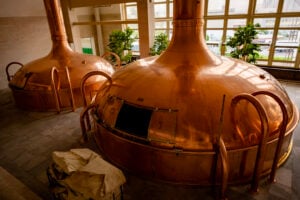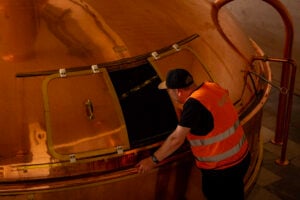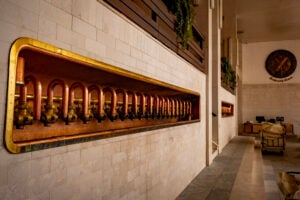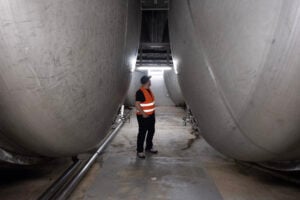A Journey Into Czech Lager with Budvar pt2
In the first part of our special blog series we learned about the history of Pilsner, the amazing Budvar brewery, and the incredible ingredients they use. Now it’s time to dive into the details of their time-tested recipe…
The making of a classic
Budvar’s ingredients list may be a minimalist marvel, but the method of creating their pilsner is very detailed. And it doesn’t end in the brewhouse – like many Czechs, Budvar believe the way the beer is served is a vital part of the process. More on the serve below!


Budvar use decoction mashing. This is a method where part of the mash is moved to a second vessel and heated separately – even boiled – from the remainder before being added back in. There are multiple temperature rests and Budvar do two separate decoctions as part of a mash that can last nearly five hours.
Decoction mashing dates back hundreds of years. Historical malts were less “modified” than modern malts – meaning they needed more work to get the enzymes to break down and release sugars. The multiple steps involved allow better efficiency from less-modified malt. The other main advantage is in heating: it’s easier to heat a small portion of a mash than the whole thing. So by superheating one part and mixing it back in, you raise the temperature of the whole mash. This was particularly important in the days before steam jackets or electric heating elements!
Budvar’s decoction method begins with an initial infusion at 37°C. This is what’s called an “acid rest” – an enzyme in the malt called phytase helps lower the pH of the mash without the need for separate acids. This is needed because the water from their aquifer is so low in minerals and the barley is so pale. Another enzyme, beta glucanase, is also active here, which works to make the mash less gummy and sticky.
Another infusion raises the mash temperature to 50°C. This “protein rest” helps an enzyme called protease to break down starches in the malt, helping with clarity of the wort, as well as mouthfeel and head stability in the final beer.
With this rest complete, it’s time for the first decoction. Part of the mash is pumped into a separate decoction kettle, where it’s heated up by 1°C per minute until it reaches 75°C. It’s held here for a short rest, then brought to a boil. The boil deactivates all the enzymes in the malt and also helps darken it through Maillard reactions, bringing out bready flavours.
The decoction is returned to the main mash tun, which helps raise the temperature of the whole mash to 65°C – the usual beta amylase rest we use in other mashing methods. This produces the majority of the fermentable sugars that the yeast will act on.
This rests for a while before a second decoction is taken. Once again, part of the mash is pumped to the decoction kettle, and this time it is raised to 75°C and then boiled again. It’s possible that some of the second decoction is the same that went into the first – this means even more Maillard browning and bready flavours are produced.
Returning the second decoction to the main mash tun raises the overall mash temperature to 75°C. The only enzyme active here is alpha amylase, which produces less fermentable sugars that help with body and mouthfeel. At the end of this rest, the mash is sparged at 75°C.
Hot side aeration
We know that oxygen is good for fermentation and bad for finished beer, but many brewers also try to avoid introducing oxygen during the mash. Too much oxidation at this point – known as “hot side aeration” (HSA) – brings the risk of staling compounds forming, as well as darkening the wort. For some, HSA is to be avoided at all costs.
The traditional equipment used by Budvar and other Czech breweries – especially the grant – means that HSA is much more likely. Budvar don’t mind this – they actually see it as a good thing, with the colour and flavour compounds adding to the final product. So whether HSA is a bad thing depends on your point of view!
One of the clever aspects of decoction mashing is how it can unlock extra efficiency. The longer chain sugars extracted by alpha amylase require higher temperatures – which the two decoctions achieve with extended periods around 75°C. When the decocted portions are returned to the main mash – which waits at lower temperatures – these long chain sugars are available to be acted on by beta amylase, breaking them down into simpler sugars.
With single infusion mashing this is nearly impossible – extended periods at +70°C denatures and deactivates beta amylase. So starting at 75°C and letting your mash cool to 65°C wouldn’t get the same result as decoction.

You might wonder why, if it can give better efficiency, all breweries don’t use decoction. And the simple answer is that it can be a bit of a faff! You need additional vessels and equipment, plus moving hot mash around is not something you do for fun. And it’s worth reiterating how long and slow the process is: a usual mash at Budvar takes between four and five hours. It’s a massive investment not only in the brewhouse but also in time.
The boil and hop additions
Budvar boil for ninety minutes. The longer boil drives off more dissolved oxygen – going some way to counteract the long-term negative effects of HSA mentioned earlier.
The initial hop dose is added while the kettle is still being filled: a “first wort hop” addition (FWH). It’s commonly thought that first wort hopping delivers a smoother, less harsh bittering, but Budvar have a second reason for choosing it. They use only whole leaf hops, never pellets or hop extracts, and at the scale they brew at, it can take nearly half an hour for the hops to fully saturate in the wort. So the FWH addition is being isomerised for the entire boil, rather than just the last sixty minutes.
Two more hop additions are made, when a rolling boil starts at ninety minutes, and with thirty minutes to go. The different timing provides layers of subtly different bitterness.
Given the scale of each brew – 600HL at a time, sixty thousand litres! – the amount of hops added to the kettle is mind-boggling. However, the IBU level is kept to a low ~20. The lower bitterness compared to some other Czech pilsners means the bready decocted malt flavours and crisp yeast bite have more room to express.
Fermentation and maturation

After the boil, the wort is cooled down to 7°C and pumped to the fermentation tanks. The yeast is pitched and temperature capped at 10°C. The amount of yeast is not to be underestimated: half a litre of thick yeast for every 1000L. That’s a pitch rate of 15-20 million yeast cells per millilitre – a great deal more than many homebrewers ever consider.
The original gravity of the yeast is approximately 1.048 – or 12° on the Plato scale that Budvar use. This measures the amount of sugar in solution, so 12° means the wort is 12% sugar. The brewmasters know their yeast requires one day of fermentation for each degree Plato, so that’s twelve days of primary fermentation.
While many brewers raise the temperature up to break down diacetyl, an off-flavour compound naturally produced in fermentation, Budvar keep the beer at a maximum of 10°C for the entire primary fermentation. Instead, to make sure the beer doesn’t have any off-flavours and leaves the brewery at its best, it goes through an extended period of lagering (cold maturation).
At the end of the twelve days, the beer is transferred to lagering tanks where it spends ninety days at 2°C. They don’t use any finings, allowing the beer to naturally clear in the tank instead. In this long period of waiting, the yeast cleans up byproducts like diacetyl and “smoothes out” any sharp edges of flavour. Patience is the name of the game here!
Join us in the next part of this blog where we find out how to pour the perfect pilsner, then in part four we cover how to make your best Pilsner at home – including how to adapt Budvar’s methods at homebrew scale.
Plus you can check out our four part video series with Budvar as we dig deep into the secrets of Czech lager! And remember to subscribe to our YouTube channel for all the latest brews and reviews from The Malt Miller.

